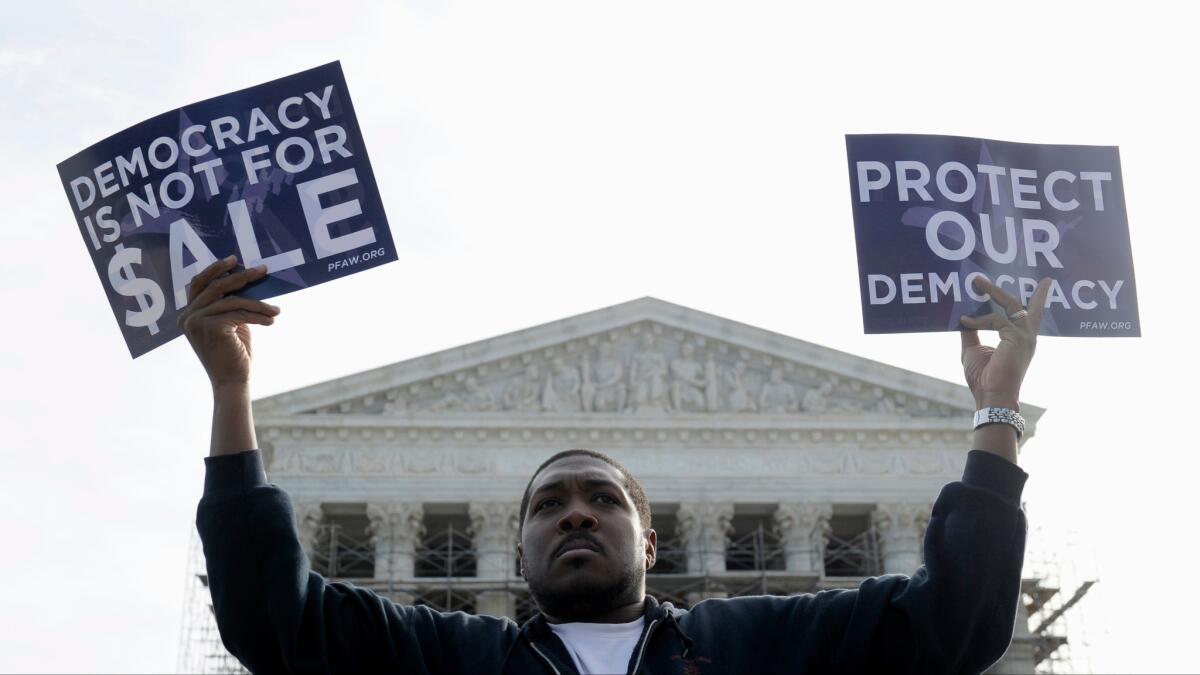Op-Ed: States can bring political ‘dark money’ into the light

- Share via
Dark money — campaign spending from undisclosed sources — is seeping into the 2016 election at a rate unmatched in U.S. history. Sham nonprofit organizations and limited liability companies put blinders on voters. Further, as I’ve seen firsthand during my three years on the Federal Election Commission, misguided court decisions and my own agency’s dysfunction have completely hampered the ability to ensure accountability in election spending on a nationwide level.
Voters have a right to know who is paying for a political campaign before they go to the polls. Given how easily dark money is shuttled around the country, a national solution would be best. But until that happens, states and cities can take steps to improve transparency in campaign spending.
In California, where I used to chair the state’s Fair Political Practices Commission, strong state campaign finance laws and a commitment to enforcement exposed who was spending millions on campaigns. As a result, dark money in California has been kept to a minimum.
A notable example came in 2012, when the FPPC investigated the largest anonymous donation in the history of California politics. Ultimately we uncovered a web of secretive nonprofits stretching from Virginia to Iowa to Arizona that colluded to funnel $15 million into ads about two state ballot measures. California’s robust disclosure laws led to a record $1-million fine against two of those donor groups — and would have permitted the state to collect another $15 million from the political action committee that spent the donations.
At the time, however, California’s laws did not require disclosure of the individual donors hiding behind these layers of nonprofits. The state Legislature passed measures in 2014 to remedy that. So this November, when Californians vote on whether to renew Proposition 30, the tax that was one of the ballot measures targeted by dark money in 2012, they stand a much better chance of learning who is supporting or opposing it.
A new report on a study by the Brennan Center for Justice at New York University School of Law quantified what a difference strong transparency laws have made in California. The study analyzed outside spending in six states — Alaska, Arizona, California, Colorado, Maine and Massachusetts — between 2006 and 2014. California saw by far the greatest total amount of outside spending, which includes all election spending that is not coordinated with a candidate: a minimum of $75 million in a cycle. Still, no more than $2 million of it was dark money. California, as a result of its 2014 reforms, was the only state to see dark money actually drop between 2010 and 2014.
Even California could ... make it much easier for voters to access information about the true sources of campaign money.
By contrast, in the five other states with weaker transparency requirements, average dark money expenditures shot up nearly threefold between 2010 and 2014. Arizona was particularly egregious; dark money there skyrocketed from about $600,000 in 2010 to more than $10 million in 2014. Unfortunately, Arizona doesn’t recognize how this is undermining its elections. In March the Arizona Legislature actually voted to significantly weaken its state oversight of anonymous campaign spending.
I’ve advocated repeatedly that the federal government could learn from California. But given the gridlock in Washington, some cities and states — Connecticut, Montana, New York City and Austin, Texas — have seized the lead. Among their reforms: requiring nonprofits that buy political ads to disclose their relevant donors, and for those donors to disclose their donors. Some also require that top donors’ names appear on any advertisement. Some governments require each politically active group to name the individual who controls its election activity, which provides a starting point for uncovering the networks behind meaningless nonprofit names like “Americans for Apple Pie.”
Even California could make its laws stronger. For example, it could enshrine the public’s right to transparency in all campaign spending in the state’s Constitution as a way to advance democratic self-government and protect the integrity of the electoral process. It also could make it much easier for voters to access information about the true sources of campaign money.
At the national level, unfortunately, we are a long way from compelling transparency in political spending from outside groups. Already, $37 million of dark money has been spent this election cycle — three times the amount spent at this point in 2012. Meanwhile, three of my fellow FEC commissioners who are ideologically opposed to campaign finance regulation have blocked the agency from updating its disclosure rules to bring this spending into the light.
Ideally, curbing dark money will someday get a national solution. In the meantime, local and state measures to increase transparency can make an impact, and California’s efforts serve as a model for the rest of the country.
Ann M. Ravel has served on the Federal Election Commission since 2013 and chaired the commission in 2015.
Follow the Opinion section on Twitter @latimesopinion and Facebook
A cure for the common opinion
Get thought-provoking perspectives with our weekly newsletter.
You may occasionally receive promotional content from the Los Angeles Times.






